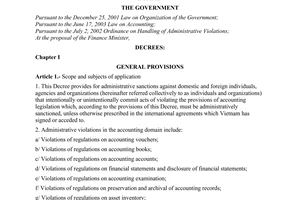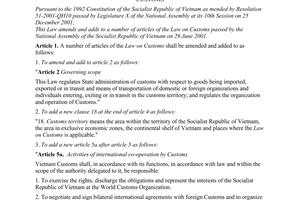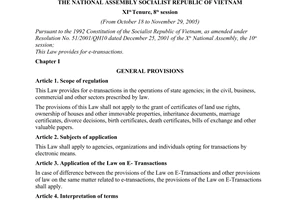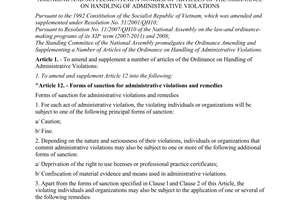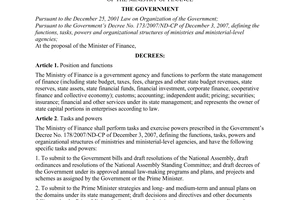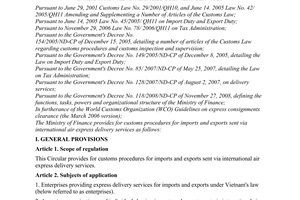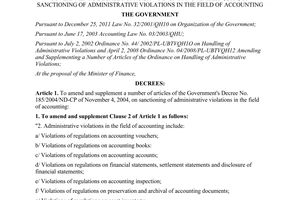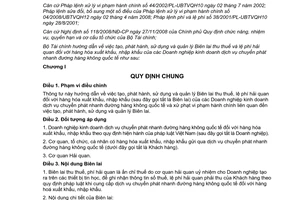Nội dung toàn văn Circular No. 178/2011/TT-BTC guidelines for the making, issuance, use and manage
|
MINISTRY
OF FINANCE |
SOCIALIST
REPUBLIC OF VIETNAM |
|
No.: 178/2011/TT-BTC |
Ha Noi, December 12, 2011 |
CIRCULAR
GUIDELINES FOR THE MAKING, ISSUANCE, USE AND MANAGEMENT OF TAX RECEIPTS, CUSTOMS FEES FOR IMPORT – EXPORT GOODS OF ENTERPRISES DOING BUSINESS IN INTERNATIONAL AIRLINE EXPRESS SERVICE.
Pursuant to the Accounting Law No. 03/2003/QH11dated June 17, 2003; Law on tax management No. 78/2006/QH11 dated November 29, 2006; Law on Customs No. 29/2001/QH10 dated June 29, 2001; Law No.42/2005/QH11dated June 14, 2005 amending and supplementing some articles of the Law on Customs; Electronic Transaction Law No. 51/2005/QH11 dated November 29, 2005 and the attached guiding documents.
Pursuant to the Ordinance on handling of administrative violations No.44/2002/PL-UBTVQH10 dated July 02, 2002; Ordinance on amending and supplementing some articles of the Ordinance on handling of administrative violations dated 04/2008/UBTVQH12 dated April 02, 2008 ; Ordinance on fees and charges No. 38/2001/PL-UBTVQH10 dated August 28, 2001 ;
Pursuant to the Decree No. 118/2008/ND-CP dated November 27, 2008 of the Government stipulating the functions, duties, rights and organizational structure of the Ministry of Finance;
The Ministry of Finance makes guidance on the making, issuance, use and management of receipt of tax and customs fees for the import export goods of the enterprises doing business in international airline express service.
Chapter I
GENERAL REGULATION
Article 1. Scope of adjustment
This Circular make guidance on the making, issuance, use and management of tax receipts, customs fees for the import and export goods (hereafter called receipt in brief) of the enterprises doing business in international airline express service and penalty of administrative violations relating to the making, issuance, use and management of receipts.
Article 2. Subjects for application
1. The enterprises doing business in international airline express service for the import and export goods in accordance with the current regulations of the Vietnamese Law (hereafter referred to as Enterprise)
2. The organs, organizations and individuals that have import and export goods sent via the international airline express service (hereafter referred to as Customer)
3. Customs authority
Article 3. Content of receipt
1. The tax receipts, customs fees are tax printed documents authorized by the customs authority to the enterprise for their making on informatic equipment in order to record information on tax number, customs fees that must be collected from customers as prescribed by law when providing the international airline express service for the import and export goods
2. Detailed content of receipt:
2.1. Required content on receipt:
- Receipt name: Tax receipt, customs fees;
- Receipt form symbol: is the information showing the name of receipt, copy number, ordinal number in a type of receipt;
- Receipt symbol: is the sign for differentiating receipts by Vietnamese alphabet system and year of receipt issuance;
- Serial number: is the code of receipts
- Name of receipt copy: Receipt copy is pages in the same receipt number. Each receipt number must have more than 2 copies and not more than 9 copies and they must show the same content, in which:
+ Copy 1: Kept at the enterprise
+ Copy 2: Delivered to the customs authority (where the enterprise has registered its customs declaration sheet)
+ Copy 3: Delivered to customer
+ Copy 4 onwards must be named under the right purpose of its use
- Ordinal number of Receipt: is the ordinal number in the series of natural numbers of symbol receipt including 07 digits in a receipt symbol;
- Name, address, tax ID of customer;
- Number of customs declaration sheet, date……month…….year; Registered at the Branch of customs…..under the management of Department of customs……….
- Account number…..;
- Mode of payment…….;
- Name, address, tax ID of enterprise;
- Import tax; special consumption tax; VAT; total amount of money (written in figure and letter)
- Customs fees (if any);
- Total tax, customs fees to be paid;
- Full name of person making receipt, date, month, year of making
- Receipts are presented in Vietnamese language or Vietnamese language without marks to ensure not to cause any misunderstanding of the receipt. In case there is a need to add a foreign language then it must be placed on the right in parentheses ( ) or right below the Vietnamese language line with the size of letters smaller than Vietnamese letters
The amount of money written on receipt is natural numbers: 0, 1, 2, 3, 4, 5, 6, 7, 8, 9; the enterprise selects one of the two ways of writing the number as follows:
+ After the thousandth, millionth, billionth, trillionth, quadrillionth, quintillionth figure, there must be a point (.); if writing figure after the unit position, there must be a comma (,) after the unit position figure.
+ After the thousandth, millionth, billionth, trillionth, quadrillionth, quintillionth figure, there must be a comma (,); if writing figure after the unit position, there must be a comma (.) after the unit position figure.
Each form of receipt used for an enterprise must have the same size
2.2. Optional content:
Besides the required content as directed at the point 2.1, clause 2 of this Article, the enterprises of express service can create additional information to serve the activity of management and business (including logos, images for decoration or advertising)
The additional information must ensure the conformity with the law currently in force, not hide or obscure the content required to exist on receipt.
Article 4. Responsibility of the enterprise and customs authority
1. Responsibility of the enterprise:
1.1. Making, distributing, using and managing receipt as directed in the Article 5 of this Circular; not making, distributing, using and managing receipt against the regulation that leads to appropriation of tax and fees of the State or customers’ money.
1.2. Sending notice of receipt issuance and reports as directed in this Circular (hereafter referred to as Report)
1.3. The enterprised are entitled to make receipts and deliver to customers as directed in this Circular.
2. Responsibility of customs authority
2.1. The General Department of customs (Administration and Finance Department) bases on the receipt issuance content of the enterprises as directed in Article 6 of this Circular to organize to build information data system on the issuance of receipt on the website of the General Department of customs so that all organizations and individuals could look up the necessary content on receipts that is announced to be issued of the enterprises.
2.2. Controlling the making, issuance, use and management of receipt of tax and customs fees of the enterprises as directed in Article 8 of this Circular.
2.3. To check the notice of issuance of receipts and reports sent by enterprises
Chapter II
MAKING, ISSUEING, USING AND MANAGING RECEIPTS
Article 5. Making receipt
1. Receipt made must ensure:
1.1. The application software used to print Receipt must meet security requirement by the right division for the users, persons who are not divided the right do not interfere to make changes of data on the application.
1.2. The ordinal numbering is done automatically; each copy of a receipt number is printed only one time.
2. Receipt must be made on same day or consecutive day (including Saturdays, Sundays and holidays) with the date of the customs declatation sheet
3. The content written on the receipt copies with the same number must be identical. The content on receipt must be consistent with the content of arising economic techniques; not erased or altered; ink used with the same color, unfaiding ink type, red ink must not be used; figure and letter must be continuous without interruption, do not write or overprint the printed letters and cross the empty part (if any); the information shown on receipt must match the information in the customs declaration sheet and other documents in the customs dossier.
Article 6. Notice of receipt issuance
1. The enterprises before using self-made Receipts as directed in Article 5 must make notice of receipt issuance under the form No.1 as promulgated together with this Circular.
2. The notice of receipt issuance consists of the name of unit issuing receipt, tax ID, address, telephone number, receipt type issued ( name of receipt type, receipt symbol, use starting date, sample receipt), date of making notice for receipt issuance, name, signature of the legal representative and the enterprise’s seal.
In case there is a change on business address or the content issued, the enterprise must send Notice of receipt issuance to the provincial/municipal Department of customs where the enterprise has registered for receipt issuance.
In case the enterprise sends notice of issuance from the second time onwards, if there is no change on the content and receipt form then there is no need to enclose sample receipt.
3. The sample receipt is the printing copy that shows complete and correct criteria of the receipt copies delivered to customer for the type issued with the receipt number of a series of 0 figures printed or affixed with the word “Sample” on the receipt. On the self-printed receipt form, there must be signature, full name of the head of organization.
4. Notice of receipt issuance and sample Receipt must be sent to the provincial/municipal Department of customs where the enterprise has registered customs declaration sheet within a period of ten (10) days from the date signing the Notice of receipt issuance. The Notice of receipt issuance including sample receipt must be posted right at the establishments using Receipt during the time of using receipt
In case the enterprise has units directly under and branches that are using receipt form in common of the enterprise then each unit directly under and branche must send notice of receipt issuance to the provincial/municipal Department of customs where the enterprise has registered customs declaration sheet
5. Within 10 days from the date receiving the Notice of receipt issuance and sample receipt, the provincial/municipal Department of customs where receiving the Notice of receipt issuance of the enterprise have responsibility to notify the information of receipt issuance on the website of the customs branch. In case the Notice of receipt issuance found to have insufficient content as prescribed then within ten (10) working days from the date receiving the Notice of receipt issuance, the provincial/municipal Department of customs where receiving the Notice of receipt issuance of the enterprise must give the enterprise a written notice. The enterprise is responsible for modification for the Notice of new receipt issuance.
Article 7. Use of receipt
1. Principles for using receipt
1.1. After making receipt, the enterprise delivers receipt to customer as directed in this Circular when completing customs procedure.
1.2. Receipt must be used in the correct ordinal number from the small number to the big one without skipping any number
1.3. The customer is entitled to use the legal Receipt for accounting record of the activity of sale and purchase of goods and service as prescribed by the law on accounting; declarating and discounting tax and fees in accordance with regulation.
2. Handling receipts made:
2.1. In case receipt made but not yet delivered to customer, if finding the receipt wrongly made, the enterprise crosses the copies and stores the number of wrongly made receipt
2.2. In case receipt made and delivered to customer but the enterprise hasnot delivered goods and provided services to customer, if found wrongly made, receipt must be destroyed. The enterprise and customer must take the minutes for revocation of receipt copies wrongly made. The minutes of receipt revocation must show the reason for the receipt revocation. The enterprise crosses the receipt copies and stores the receipt number wrlongly made and conducts the making of new receipt as prescribed.
2.3. In case receipt made and delivered to customer including goods delivery and services supply, if errors are found or in case the customs authority fixes tax for the customs declaration sheet of tax collected.
2.3.1. For the case to adjust the tax increase and customs fees to be paid: the enterprise makes more new receipts showing the tax number, fees of adjusted increase in which clearly recording the increase adjustment for Receipt No…, symbol…
2.3.2. For the case to adjust the tax decrease and customs fees to be paid: the enterprise and customer must take the minutes or have a written agreement in which clearly stating the error or the reason for tax and fees adjusted decrease; decrease adjustment for Receipt No…, symbol…
2.4. In case receipts made as prescribed, but after that the enterprise or Customer losses, burns or damages the copy 2 of the original receipt made then the enterprise and customer take the minutes recording the matter, in the receipt clearly stating Copy 1 of the receipt the enterprise has declared, paid tax and customs fees in which month, signing and writing full name of the legal representative (or authorized person), sealing (if any) on the minutes and the enterprise makes a photocopy of copy 1 of the Receipt signed by the legal representative and sealed on the receipt copy in order to deliver to customer. The customer is entitled to use copy of receipt enclosed with the minutes of the loss, burning and damage of copy 2 of the receipt used for accounting document and tax declaration. The enterprise and customer must take responsibility for the accuracy of the loss, burning and damage of the receipt
2.5. In case receipt made but the customer refuses to receive the goods or change the mode of customs clearance then the enterprise revokes the receipt and handles the matter as directed in paragraph 4 of Article 8 of this Circular.
2.6. The handling of taxes and fines paid in excess will be carried out as directed in Article 9, Circular 100/2010/TT-BTC dated 07.09.2010 of the Finance Ministry.
3. Using illegal receipt
3.1. Using illegal receipt is using fake receipt, receipt of no use value and out of use value.
The fake receipt is made under the form of receipt issued by the other enterprise or made by the same number of the same receipt symbol.
Receipt of no use value is the receipt made as directed in this Circular, but the issuance notice hasnot been completed yet.
Out of use value Receipt is the one whose procedures for its issuance is completed but the enterprise makes notice not to keep using any more; types of receipt lost after the issuance notice are reported lost to the provincial/municipal Department of customs where the enterprise has registered the customs declaration sheet; the Receipt of enterprise that has stopped using its tax ID (also known as closing tax code).
3.2. Some particular cases of illegal receipt:
- Receipt whose content recorded is not real partly or wholly
- Receipt shows the disparity in tax, customs fees or misleading the criteria required between copies of receipts.
4. Using receipt improperly
4.1. Using receipt improperly is the fraudulent making of receipts; giving or selling receipt not yet made to other enterprise for use; giving or selling receipt made to the organization and individual to keep business account, declare tax or make payment of budget capital; making receipt without complete recording of content required; making receipt with false content among copies or false content with the customs dossier.
4.2. Several particular cases specified using receipt improperly
- Using receipt of other enterprise to commit tax fraud, not to declare for tax payment
- Using receipts that the customs authority, the police or other authorities have concluded the use of receipt is illegal.
Article 8. Receipt management
1. Every 6 months periodically, before the 10 th day of the next month, the enterprise is responsible for submitting report on the situation of receipt using to the provincial/municipal Department of customs where the enterprise has registered the customs declaration sheet under the form No.3 promulgated together with this Circular.
In case the Report doesnot ensure sufficient content as prescribed, within ten (10) working days after receiving the Report, the provincial/municipal Department of customs where the enterprise’s report is received must notify the enterprise in writing. The enterprise is responsible for modification to make a new Report.
Every 6 months periodically, the provincial/municipal Department of customs where the enterprise’s report is received is responsible for making report on the task of examining, inspecting and settling complaint and denoucement on violation of receipt.
2. The enterprise is responsible for managing receipt made or not yet made, in case the receipt made or not made is found lost, burnt, damaged, the enterprise must make report on the loss, burning, damage and notify the provincial/municipal Department of customs where the enterprise has registered the customs declation under the form No.2 promulgated together with this Circular, not later than five (05) days from the date the loss, burning or damage of receipts occur.
3. Storing and maintaining receipt
Receipt is stored in the computer system under the confidentiality policy; storing and maintaining in accordance with regulation on storing and maintaining accounting documents. The storing must ensure that when there is requirement from the competent authority, it must be exploited, verified and printed out the receipt from software.
4. Receipt destruction
4.1. Receipt determined to be destroyed:
- Receipt printed on trial, in duplicate, in excess, in corrupt are specified to be fully destroyed when it is no longer in the original form of any Receipt or there is no letters on receipt to combine, photocopy or restore in the original form.
- Receipt is determined to be completely destroyed if the software making the receipt is interfered so that it could not continue to make receipt.
4.2.
Cases of receipt destruction
- Receipt that is printed in error, in duplicate, in excess must be destroyed.
- Enterprise that does not continue to use receipts must destroy them. The time limit for destroying receipts is within thirty (30) days at the latest from the date of notifying the provincial/municipal Department of customs where the enterprise has registered the customs declaration sheet. In case the enterprise still keeps the Receipt that is for the cases the customs authority has announced the end of use value. The time limit for receipt destruction is ten (10) days from the date there is notice from the customs authority of the end of use value or from the date the lost receipt has been found.
- The types of receipt that are made from the accounting units are destroyed as prescribed by the law on accounting
4.3. Procedures for destroying receipts of enterprise
4.3.1. Procedures for destroying paper receipt:
- The enterprises must set up the Inventory of receipts for destruction
- The enterprises establish a Council for receipt destruction. It must have a representative of the leaders, representative of accounting department of the enterprise.
- The members of the Council for receipt destruction must sign the minutes of Receipt destruction and take responsibility before law if there is any mistake;
- Record for receipt destruction includes:
+ Decision on establishment of the Council for receipt destruction’
+ The Inventory of receipts for destruction written in detail: Name of Receipt, Receipt symbol, amount of receipts destroyed (from number…..to number…..or detailing each receipt number if the receipt number for destruction is not consecutive.
+ Minutes of receipt destruction;
+ Notice of receipt destruction result must have the content: type, symbol, amount of Receipt destroyed from number….to number.., reason for destruction, date and time of destruction, method of detruction under the form No.4 promulgated together with this Circular.
Record for receipt destruction is stored at the enterprise that uses the receipt. For the Notice of receipt destruction result is made into two (02) copies, one copy sent to the provincial/municipal Department of customs where the enterprise has registered the customs declaration sheet not later than five (05) days at the latest from the date of performance of receipt destruction.
4.3.2. Procedures for destroying receipt on software:
- Receipt that hasnot been made yet must be destroyed on the software, ensuring the software for making receipt is interferred in order not to keep making receipt.
- Receipt that has been made is destroyed as directed at the point 4.3.1, clause 4 of this Article and the performance of destruction is as directed at point 4.3.2, clause 4 of this Article.
- The alteration, erasement and printing of receipt on the software must ensure the historical nature
Chapter III
PENALTY FOR VIOLATION OF RECEIPT
Article 9. Penalty for acts of violation of regulations on Receipt
1. Penalty for violation of receipt will comply with regulations as prescribed in Decree No. 185/2004/ND-CP dated November 04, 2004 concerning the penalty for administrative violation in the field of accounting and Decree No. 39/2011/ND-CP dated May 26, 2011 amending and supplementing some articles of Decee No. 185/2004/ND-CP.
2. In case of violation on Receipt that leads to the wrong declaration and result in shortage of tax and fees to be paid or increase of tax and fees to be reimbursed or leads to tax avoidance, tax fraud then these acts must be penalized in conformity with regulation of the law on tax and customs.
Article 10. Competence for penalty of receipt violation
1. Competence for penalty of receipt violation is implemented as prescribed in Articles 29, 30, 36 và 38 of the Ordinance on handling of administrative violations of Vietnam and Decree No. 185/2004/ND-CP dated November 04, 2004 concerning the penalty for administrative violation in the field of accounting
and Decree No. 39/2011/ND-CP dated May 26, 2011 amending and supplementing some articles of Decee No. 185/2004/ND-CP.
2. In case of violation relating to the activity of printing fake Receipt to the extent of criminal prosecution, the case must be transferred to the competent authority for prosecution as prescribed by the law.
3. The organ that conducts the proceedings has responsibility to announce the result of handling acts of violation on Receipt to the organ proposing the criminal prosecution.
4. For the case whose penalty has been imposed, if the acts of violation found to have signs of crime whose limitation for criminal prosecution has not expired then the person who makes decision on the penalty must cancel this decision and within the period of three (03) days from the date of cancellation of the penalty decision, the record of the case of violation must be transferred to the competent criminal proceedings authority.
Chapter IV
EXAMINATION, INSPECTION AND SETTLEMENT OF COMPLAINT AND DENOUCEMENT ON VIOLATION OF RECEIPT.
Article 11. Examining and inspecting the printing, issuance, management and use of Receipt
1. Examining at the head office of customs authority
1.1. The customs authority where the customs declaration sheets are registered will monitor the making, issuance, management and use of receipt based on the report on the situation of receipt using of the enterprises. A maximum of ten (10) working days after receiving a report on the situation of receipt using from the enterprise, the customs authority must conduct the examination.
1.2. In case the customs authority examines and detects signs of violation, within three (03) working days from the date of detection, the customs authority send written request to the enterprise for its explanatory report.
Within three (03) working days from the date receiving explanatory request, the enterprise must send its explanatory report to the customs authority.
2. Examining Receipt at the head office of the enterprise using receipt.
2.1. In case the enterprise fails to explain or giveasunadequate explanation, the customs authority will promulgates decision on receipt examination at the head office of the enterprise.
2.2. The content of receipt examination is particularly specified in the decision on examination at the head office consists of: the legal basis for examination, subjects of examination; content, scope of examination; time for examination, head of examination group and the members of the examination group, rights and responsibility of the examination group and subjects of examination.
2.3. The customs authority where the enterprise has registered its customs declaration sheet makes decision on receipt examination together with the examination after customs clearance and is responsible for the decision on examination.
2.4. Within three (03) working days from the date signing decision, the decision on Receipt examination at the head office of the enterprise must be sent to the enterprise. Within three (03) working days from the date receiving the decision on Receipt examination or before the time of conducting the receipt examination at the head office of the enterprise, if the enterprise demonstrates the making, issuance, use and management of receipt as prescribed then the Head of the customs authority makes a decision on cancelling the decision on Receipt examination
2.5. A maximum of not more than ten (10) working days from the date of promulgation of decision on examination, the customs authority must conduct the receipt examination at the head office of the enterprise.
The time for receipt examination at the head office of the enterprise will not exceed five (05) working days from the date starting the examination. In necessary case, the Head of the customs authority can extend the time for examination one time, the extension period will not exceed five (05) working days.
The minutes of examination is made for each examination day
The enterprise under the examination is entitled to receive the minutes of Receipt examination and request to be explained the content of the minutes of examination and make reservation about its opinion in the Minutes of examination (if any).
2.6. Handling the result of examination:
- Within five (05) working days at the latest from the date signing the minutes of examination with the enterprise undergoing the examation, the head of examination group must make report on the examination result to the person making decision on the examination. In case there is act of violation arising that needs to be penalized administratively, then within a period of not exceeding ten (10) working days from the date signing the minutes, the Head of the customs authority must make a decision on the penalty of administrative violation. The enterprise under the examination has the obligations to comply with the decision on handling the examination result.
- If, through the examination, the violations of the management, use of receipts are detected and leads to
handle on tax, depending on the nature and seriouness of violation, the tax authority will promulgate the decision on examination and inspection of tax in conformity with the Law on Customs, Law on tax management, Law on Inspection and process of examination and inspection of tax.
3. Receipt inspection
The receipt inspection is associated with the inspection for the compliance with the law on customs tax at the head office of the taxpayer.
Article 12. Complaining, denouncing and settling complaint and denouncement on receipt
Complaint, denouncement and settlement of complaint and denouncement on receipt as directed in this Circular will comply with the regulations of the law concerning complaint and denouncement.
Chapter V
ORGANIZATION FOR IMPLEMENTATION
Article 13. Effect
This Circular takes effect since January 22, 2012
Article 14. Responsibility for implementation
1. The customs authority is responsible for publicizing and guiding the enterprises to comply with the content of this Circular, examining and handling the violations of the enterprises that use receipts.
2. The enterprises whose activities are relating to the making, issuance and use of Receipt fully implement the guidelines in this Circular.
During the course of implementation, if there is any problem and difficulty arising, the organizations and individuals should promptly report to the Ministry of Finance for study and settlement
|
|
PP. MINISTER |
------------------------------------------------------------------------------------------------------
This translation is made by LawSoft and
for reference purposes only. Its copyright is owned by LawSoft
and protected under Clause 2, Article 14 of the Law on Intellectual Property.Your comments are always welcomed




